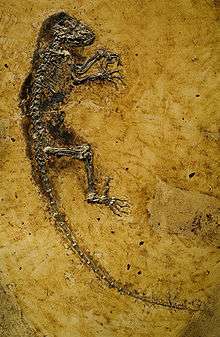Transfer technique
The transfer technique is a technique to stabilise and prepare fossils by partially embedding them in plastic resins (i.e. epoxy or polyester) in order to preserve the position of the preserved fossil once all of the rock matrix is subsequently removed. Notable examples of this technique are fossils preserved in oil shale (such as those from the Messel Pit) or other substrates that will deteriorate under atmospheric conditions, or fossils preserved in acid-soluble carbonates (such as fossils from the Santana Formation).[1] The technique is notable for delivering exquisite preparations of both very high scientific and display value.
Development
The method was pioneered by Harry Toombs and A.E. Rixon of the British Museum in 1950[2] with the introduction of the technique as a means of extracting fish fossils from acid-soluble carbonates. The technique permitted the preparation of delicate, fragmented, or otherwise unstable fossils by the removal of virtually all of the surrounding rock matrix. The resulting preparation retains the position of all of the parts of the fossil in the position in which they were preserved in the fossil. While the method developed by Toombs and Rixon calls for plastic resins, other substances, such as a mix of ground chalk and beeswax have been used.[3]
The transfer technique and the Messel fossils

While the original method was developed to deal with fossils freed from the matrix by acid, its most well known application is to the fossils from The Messel pit. These fossils, noted for their exquisite preservation, including soft tissue, body outline and even colour sheen on beetle wings, are notoriously difficult to preserve. The fossils themselves are flat, sometimes film-like on the surface of the rock layers. The oil shale contains 40% water. When a slab is broken free of surrounding rock, it will soon dry out and crack.[4] A slab with a perfect fossil will turn to a heap of rubble in a few hours, destroying the fossil with it. This was the fate of numerous Messel fossils until the transfer technique was started to be applied in the 1970s.
In order to preserve the fossils once their slab is taken out of the rock, the fossil need to be transferred from the rock surface on to a durable, artificial surface. The water in the fossil itself also needs to be replaced.
Lacquers and epoxy
As soon as the slab bearing the fossil is worked free from the rock, it is submerged in water to stop it from cracking. This involves packing it in plastic and sometimes wet newspaper. While in the wet state, it is cleaned up and all preparation needed for the transfer conducted.[5]
Once ready for transfer, the fossil (but not the surrounding rock) is dried off with a blow-dryer. As soon as the fossil starts to lighten (a sign of drying), water-soluble lacquer is applied. The lacquer will penetrate the bone and other organic remains, but not the shale itself, as shale is impenetrable to watery solutions.
When the lacquer has set, a frame of modelling clay is built on the rock face around the fossil. A two-component epoxy is poured onto the frame, forming the new artificial surface for the fossil. The composition of the resin is important, as it will have to soak into the fossil to further strengthen it and to bind it to the new surface.
Back-to-front preparing
When the epoxy has set, the slab is turned over, and preparation begins from the shale at the back. Layer by layer of oil-shale is removed with brush and scalpel. When the preparator hits the fossil, more lacquer and glue is applied to further stabilize the fragile fossil. When the work is done, all traces of oil-shale have been removed, only the fossil itself remain on the epoxy slab.[6]
The contrasting physical property of the rock and fossil are essential for this technique to succeed. The organic remains of the fossil are porous and hygroscopic, while the oil-containing rock is not. Thus, the lacquer can penetrate fossils, and not rock, enabling the preparator to “glue” the fossil to the artificial slab, without at the same time gluing it to the shale.
References
- ↑ Maisey, J.G., Rutzky, I., Blum, S. & W. Elvers (1991): Laboratory Preparation Techniques. In Maisey, j:G. (ed): Santana Fossils: An Illustrated Atlas, Tfh Pubns Inc.ISBN 0866225498. pp 99–103.
- ↑ Toombs, Harry; A.E. Rixon (1950). "The use of plastics in the "transfer method" of preparing fossils". The museums journal. 50: 105–107.
- ↑ Keller, T.; E. Frey, E., Hell, R., Rietschel, S., Schaal, S. & Schmitz, M. (1991). "Ein Regelwerk für paläontologische Grabungen in der Grube Messel". Paläontologische Zeitschrift. 65 (1-2): 221–224. doi:10.1007/BF02985786. Cite uses deprecated parameter
|coauthors=(help) - ↑ Messel Oil Shale Fossil Site Lagerstatte, Virtual fossil museum website
- ↑ Messel Research Station, Senckenberg Forschungsinstitut und Naturmuseum website
- ↑ Messel Fossils from Germany website
